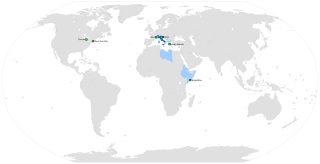
Italian is a Romance language of the Indo-European language family that evolved from the Vulgar Latin of the Roman Empire. Together with Sardinian, Italian is the least divergent language from Latin. Spoken by about 85 million people (2022), Italian is an official language in Italy, San Marino, Switzerland, and is the primary language of Vatican City. It has official minority status in Croatia and in some areas of Slovenian Istria.
Non-native pronunciations of English result from the common linguistic phenomenon in which non-native speakers of any language tend to transfer the intonation, phonological processes and pronunciation rules of their first language into their English speech. They may also create innovative pronunciations not found in the speaker's native language.

Gelato is the common word in Italian for all kinds of ice cream. In English, it specifically refers to a frozen dessert of Italian origin. Artisanal gelato in Italy generally contains 6–9% butterfat, which is lower than other styles of frozen dessert. Gelato typically contains 35% air and more flavoring than other kinds of frozen desserts, giving it a density and richness that distinguishes it from other ice creams.
Italian orthography uses 21 letters of the 26-letter Latin alphabet to write the Italian language. This article focuses on the writing of Standard Italian, based historically on the Florentine dialect, and not the other Italian dialects.

Neapolitan is a Romance language of the Italo-Romance group spoken in Naples. It is named after the Kingdom of Naples, which once covered most of the area, since the city of Naples was its capital. On 14 October 2008, a law by the Region of Campania stated that Neapolitan was to be protected.
Italian grammar is the body of rules describing the properties of the Italian language. Italian words can be divided into the following lexical categories: articles, nouns, adjectives, pronouns, verbs, adverbs, prepositions, conjunctions, and interjections.
Regional Italian is any regional variety of the Italian language.
The phonology of Italian describes the sound system—the phonology and phonetics—of Standard Italian and its geographical variants.

Tuscan is a set of Italo-Dalmatian varieties of Romance spoken in Tuscany, Corsica, and Sardinia.
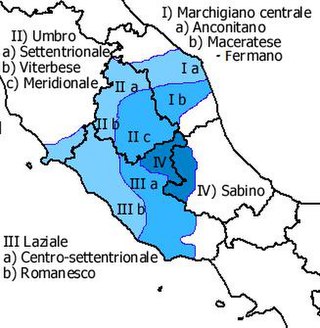
Romanesco is one of the central Italian dialects spoken in the Metropolitan City of Rome Capital, especially in the core city. It is linguistically close to Tuscan and Standard Italian, with some notable differences from these two. Rich in vivid expressions and sayings, Romanesco is used in a typical diglossic setting, mainly for informal/colloquial communication, with code-switching and translanguaging with the standard language.
The Tuscan gorgia is a phonetic phenomenon governed by a complex of allophonic rules characteristic of the Tuscan dialects, in Tuscany, Italy, especially the central ones, with Florence traditionally viewed as the center.
Eastern Lombard is a group of closely related variants of Lombard, a Gallo-Italic language spoken in Lombardy, mainly in the provinces of Bergamo, Brescia and Mantua, in the area around Cremona and in parts of Trentino. Its main variants are Bergamasque and Brescian.
Syntactic gemination, or syntactic doubling, is an external sandhi phenomenon in Italian, other Romance languages spoken in Italy, and Finnish. It consists in the lengthening (gemination) of the initial consonant in certain contexts. It may also be called word-initial gemination or phonosyntactic consonantal gemination.

Renato Pozzetto is an Italian actor, director, comedian, and singer.
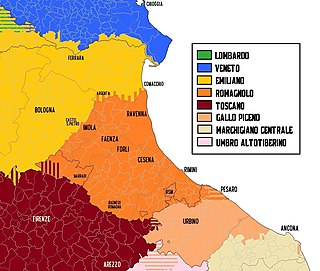
Romagnol is a Romance language spoken in the historical region of Romagna, consisting mainly of the southeastern part of Emilia-Romagna, Italy. The name is derived from the Lombard name for the region, Romagna. Romagnol is also spoken outside the region, particularly in the independent Republic of San Marino. Romagnol is classified as endangered because older generations have "neglected to pass on the dialect as a native tongue to the next generation".
The Wallachian dialect is one of the several dialects of the Romanian language (Daco-Romanian). Its geographic distribution covers approximately the historical region of Wallachia, occupying the southern part of Romania, roughly between the Danube and the Southern Carpathians. Standard Romanian, in particular its phonology, is largely based on Wallachian.
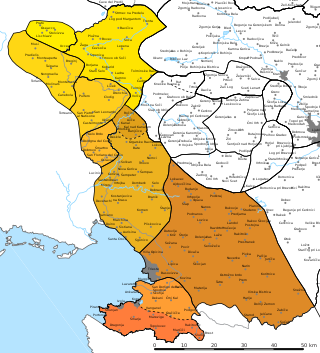
The Natisone Valley dialect, or Nadiža dialect, is a Slovene dialect spoken mainly in Venetian Slovenia, but also in a small part of Slovenia. It is one of the two dialects in the Littoral dialect group to have its own written form, along with Resian. It is closely related to the Torre Valley dialect, which has a higher degree of vowel reduction but shares practically the same accented vowel system. It borders the Torre Valley dialect to the northwest, the Soča dialect to the northeast, the Karst dialect to the southeast, the Brda dialect to the south, and Friulian to the west. The dialect belongs to the Littoral dialect group, and it evolved from Venetian–Karst dialect base.
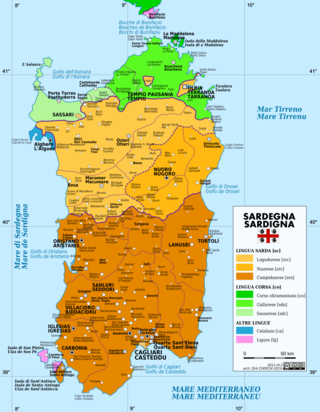
Sardinian is conventionally divided, mainly on phonological criteria, into three main varieties: Campidanese, Logudorese, and Nuorese. The last of these has a notably conservative phonology, compared not only to the other two varieties, but also to other Romance languages as well.
Palatalization in the Romance languages encompasses a variety of sound changes in Late Latin and in the languages descended from it that caused consonants to gain a palatal or palatalized pronunciation, generally through the influence of an adjacent consonant or vowel. This eventually resulted in the development of a whole series of palatal or postalveolar consonants in most Romance languages, e.g. Italian.









